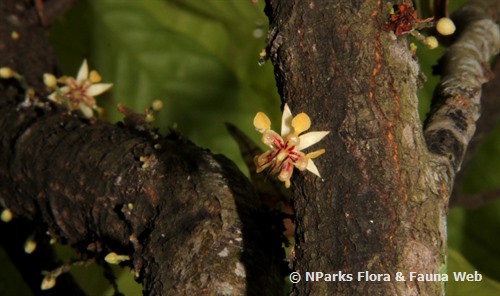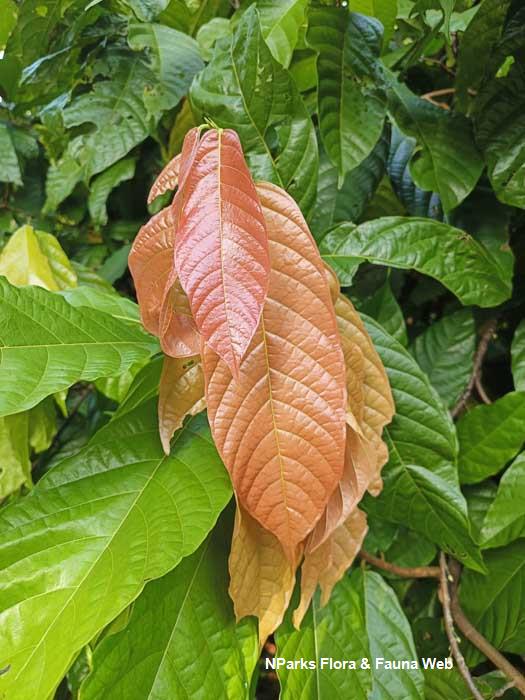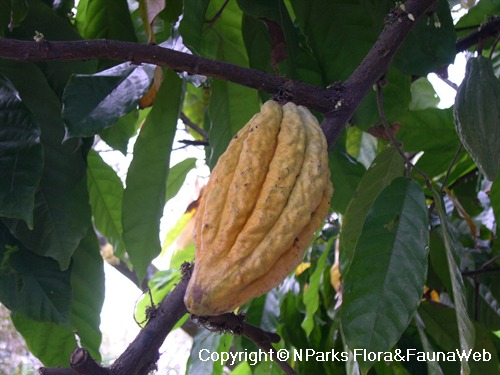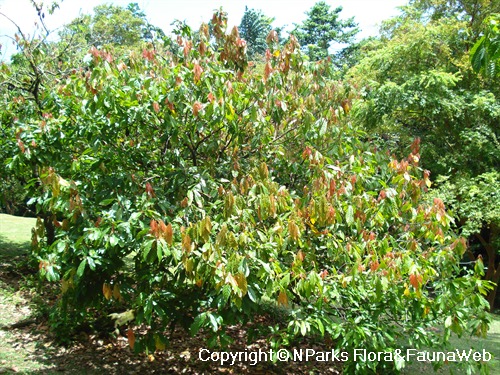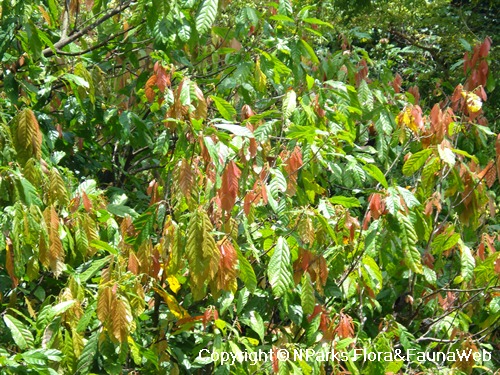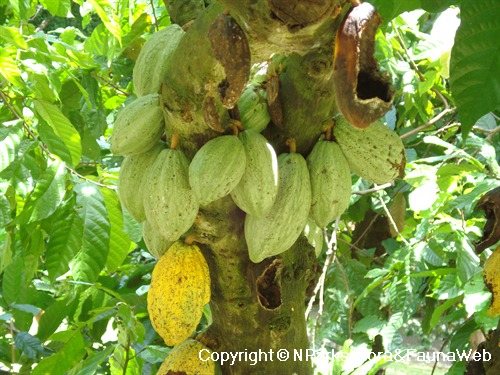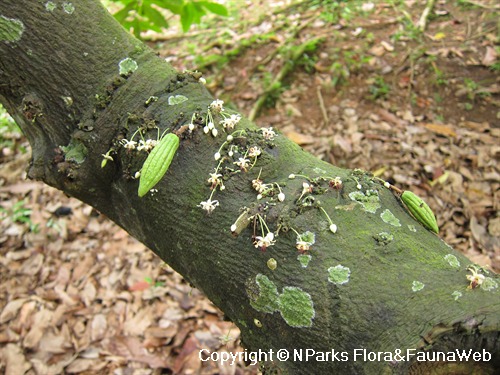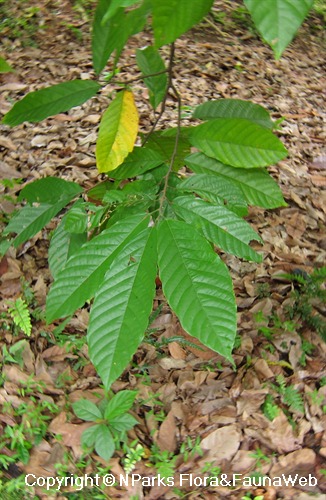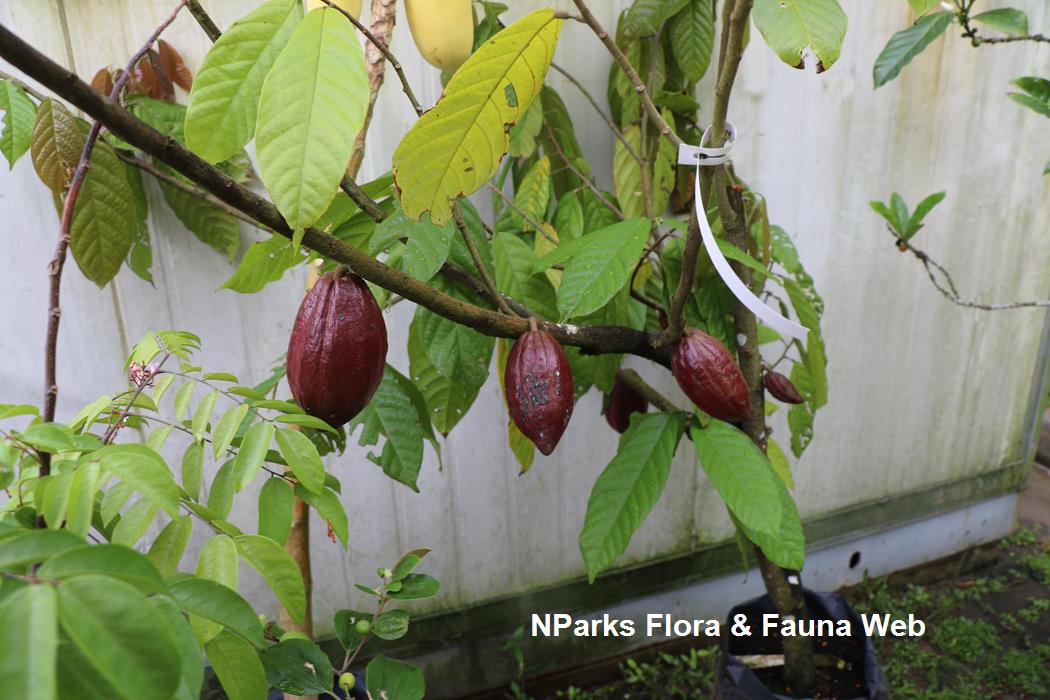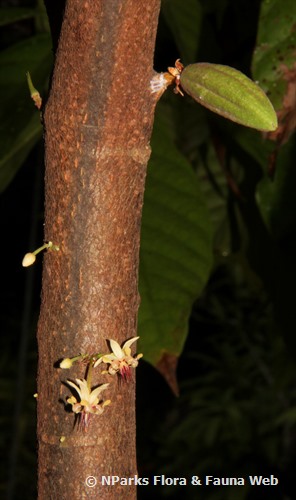
Name
Classifications and Characteristics
| Plant Division | Angiosperms (Flowering Seed Plants) |
|---|---|
| Plant Growth Form | Tree (Small (6m-15m)) |
| Lifespan (in Singapore) | Perennial |
| Mode of Nutrition | Autotrophic |
Biogeography
| Native Distribution | Mexico, Central America, northern South America |
|---|---|
| Native Habitat | Terrestrial (Primary Rainforest) |
| Preferred Climate Zone | Tropical |
| Local Conservation Status | Non-native (Horticultural / Cultivated Only) |
Description and Ethnobotany
| Growth Form | A small tree usually grows to 4-8 m tall. |
|---|---|
| Foliage | The alternately arranged leaves are large, ovate-oblong to elliptic, measuring 12-60 cm long and 4-20 cm wide. The leaf tip is pointed while the leaf base is heart-shaped or rounded. Both the main vein and the side veins are very prominent. Young flushes are reddish-pink in color, turning to dark green when mature. |
| Flowers | Flowers are small and yellowish-white or pink in color, borne on the trunk and branches. |
| Fruit | The fruit is a pod, 10-32 cm long, spherical to oblong, with 5 to 10 longitudinal ridges. Unripe fruits are white or green, turning to yellow, orange, red or purple when mature, with 20-60 seeds per fruit. Cocoa seeds are ovoid to elliptic, measuring 2-4 cm long and 1.2-2 cm wide. |
| Habitat | Lowland tropical forests up to 400 m altitude. |
| Ethnobotanical Uses | Edible Plant Parts : Edible Fruits, Edible Seeds Food (Herb or Spice): The seeds are dried and fermented in the sun to make cocoa beans. The cocoa beans then go through further processing including roasting, crushing, grinding and pressing to make chocolate and cocoa butter. Cocoa butter has many applications in food, cosmetic and pharmaceutical industries. (Fruit or Vegetable): The fruit pulp surrounding the seeds can be consumed raw or processed into desserts. Others: The shells of cocoa beans are crushed and used as mulching materials. |
Landscaping Features
| Desirable Plant Features | Ornamental Fruits |
|---|---|
| Landscape Uses | Parks & Gardens, Riverine |
| Thematic Landscaping | Economic Garden |
Fauna, Pollination and Dispersal
| Pollination Method(s) | Biotic (Fauna) (Insects (Ant, Beetle, Fly, Thrip, Wasp)) |
|---|---|
| Seed or Spore Dispersal | Biotic (Fauna) (Vertebrates (Other Mammal), Vertebrates (Human)) |
Plant Care and Propagation
| Light Preference | Semi-Shade |
|---|---|
| Water Preference | Moderate Water, Lots of Water |
| Plant Growth Rate | Fast to Moderate |
| Rootzone Tolerance | Moist Soils, Waterlogged Soils, Well-Drained Soils, Fertile Loamy Soils, Acidic (low pH) Soils |
| Maintenance Requirements | Moderate |
| Pruning | Pruning is require to maintain the desired shape. |
| Propagation Method | Seed, Stem Cutting, Grafting, Air-Layering |
| Seed / Spore Germination Duration | 5 days to 10 days |
Foliar
| Foliage Retention | Evergreen |
|---|---|
| Mature Foliage Colour(s) | Green |
| Mature Foliage Texture(s) | Glossy / Shiny, Leathery |
| Prominent Young Flush Colour(s) | Pink |
| Foliar Type | Simple / Unifoliate |
| Foliar Arrangement Along Stem | Alternate |
| Foliar Shape(s) | Non-Palm Foliage (Ovate, Elliptical) |
| Foliar Venation | Pinnate / Net |
| Foliar Margin | Entire |
| Leaf Area Index (LAI) for Green Plot Ratio | 3.0 (Tree - Intermediate Canopy) |
Non - Foliar and Storage
| Branch Angle (wrt vertical) | Acute |
|---|---|
| Trunk Type (Non Palm) | Woody |
| Bark Colour(s) | Brownish |
| Mature Bark Texture | Smooth |
Floral (Angiosperm)
| Flower Colour(s) | White, Cream / Off-White, Pink |
|---|---|
| Flower Grouping | Solitary, Cluster / Inflorescence |
| Flower Location | Cauliflorous |
| Flowering Period | Free-Flowering |
| Flower Size | 1 cm x 2 cm |
Fruit, Seed and Spore
| Mature Fruit Colour(s) | Green, Orange, Purple, Red, Yellow / Golden |
|---|---|
| Seed Description | 2-4 cm long, ovoid or elliptic, have either white or purple cotyledons. |
| Seed Quantity Per Fruit | Numerous (>20) |
Image Repository
Others
| Master ID | 1895 |
|---|---|
| Species ID | 5241 |
| Flora Disclaimer | The information in this website has been compiled from reliable sources, such as reference works on medicinal plants. It is not a substitute for medical advice or treatment and NParks does not purport to provide any medical advice. Readers should always consult his/her physician before using or consuming a plant for medicinal purposes. |

